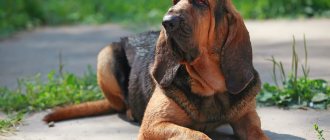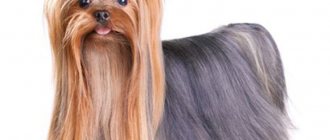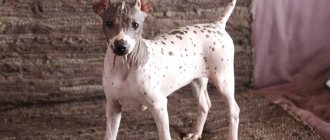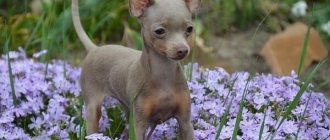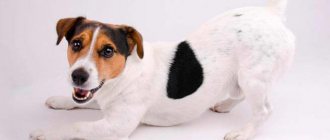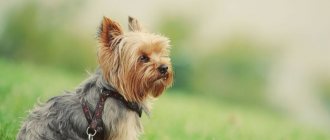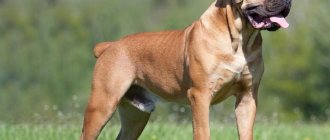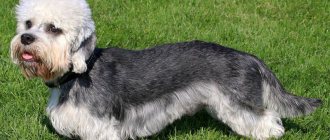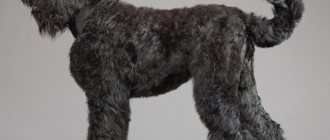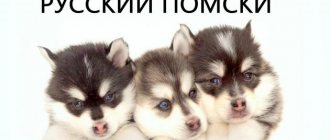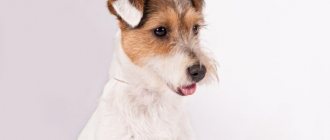Video
* We invite you to watch a video about the Norwich Terrier . In fact, in front of you is a playlist in which you can select and watch any of 20 videos about a given dog breed by simply clicking on the button in the upper right corner of the window. In addition, the material contains quite a lot of photos. By looking at them you can find out what a Norwich Terrier looks like.
In this article:
|
Rate the material!
[Total votes: 0 Average: 0]
How to choose a puppy
You can buy a healthy baby with good heredity only in an official nursery. Ask the breeder about his successful experience in breeding Norwich Terriers, the conditions in which the dogs are kept, their titles and awards (if relevant). It is quite difficult to determine by eye whether a puppy meets the breed standard, so it is worth using the services of an expert. It will protect you from purchasing a discarded Norwich Terrier that will not be able to participate in exhibitions.
Before meeting the puppies, it is worth meeting their parents. A few minutes of communication will be enough for a superficial overview of the shortcomings of adult dogs. If a bitch and a dog show cowardice or even aggression, growl in warning and do not make contact, refuse to purchase babies from these producers. It will be extremely difficult to raise docile pets from their puppies.
Norwich Terriers are put up for sale at 7-12 weeks, when they no longer need maternal care and respond adequately to the presence of other living creatures. Among all the kids, choose the most active and strong one, with an excellent appetite and a desire to learn about the world around them. A healthy puppy's coat should be shiny, its nose should be moist, and its eyes and ears should be clean. At the age of 2-3 months, the “Norwich” already has noticeable general body proportions, the position of the tail and ears, the color and structure of the coat.
When choosing a pet, be guided by the gender of the animal. Bitches can boast of a more good-natured and calm character, in contrast to wayward and disobedient males.
When buying a Norwich Terrier, it is important to receive the accompanying documentation: a veterinary passport and medical certificates indicating deworming and vaccination. Owners of show-class dogs will need a breeding certificate indicating the pedigree of the animal.
History of the origin of Norwich Terriers
The animals owe their name to the place where the breed was bred at the end of the 19th century - the city of Norfolk in the UK. Other names include Jones Terrier and Trumpington Terrier. At first they were not classified as any specific breed, but were simply called “shaggy” because of their coat. A separate species of dogs was recognized a little later.
Interesting Fact: Between 1899 and 1902, a female dog of an unknown breed was crossed with a Cantab Terrier, resulting in a puppy named "Rags". He was bred to various types of terriers, including Irish and Glen of England terriers. Frank Jones, in whose honor one of the names was given, played an important role in the formation of the breed.
In their homeland, dogs were not used as hunters, only as guard dogs. The amazing hunting abilities of the creatures were discovered by Cambridge students, whose dormitory basements were filled with hordes of rats. One of the students began breeding Norwich Terriers in his stables on Trumpington Street, and the second name of the breed was coined in her honor.
It was in this nursery that Rags was born. Frank Jones took several individuals to the USA, where he began to use them as rodent hunters, and later fox hunters. Norwich Terriers paired with Foxhounds showed amazing results. When Jones was asked in 1904 about the name of the breed, he answered without hesitation: “They are Norwich Terriers.”
The dogs drove foxes out of their holes thanks to their small size. At first, Norwich Terriers and Norfolk Terriers belonged to the same breed. However, in the second half of the 20th century, the British Kennel Club separated them. The American Kennel Club did the same in 1979. Dogs with folded ears remained Norfolk, while dogs with erect ears remained Norwich.
Feeding
The Norwich Terrier loves to eat a lot, so no matter how much he puts on his plate, he will eat it all. Owners should control portions for their pet.
The diet is selected to be balanced with all the main components: proteins, fats, carbohydrates. The obligatory presence of buckwheat, rice, fermented milk products, dietary meat, eggs, cottage cheese, cereals, vegetables and some fruits.
You can add vitamin supplements as complementary foods, which your veterinarian will recommend. It is strictly contraindicated to feed chocolate, bird bones, fatty meats, and spices.
Among artificial foods, the most suitable for Norwich are specialized mixtures for small wire-haired breeds of the highest quality. Low-quality ones lead to diseases of the gastrointestinal tract, problems with teeth and gums, and hair loss.
At a young age, ingredients rich in vitamins should be supplied. If there is a lack of any microelements, the development and growth of the baby is suspended. Upon arrival to the new owner, it is recommended to give soaked dry food, so it is gradually transferred to natural food. If you immediately feed natural food, the puppy will suffer from an upset stomach.
It is advisable to feed before the family sits down to the table, so that a well-fed animal does not beg for handouts from the table.
Norwich Terrier - description of the breed
Dogs have a compact, symmetrical body with well-developed muscles. Compact body, strong bones. Dense, stocky build, with a short, level back and a long, protruding chest. The ribs do not protrude. The body ends with a small, high-set tail. Often it is cut off at 2/3 of the length, but this is not a mandatory procedure.
The limbs are well developed, relatively thick, the paws are rounded. For burrowing dogs, it is considered justified that the front legs are less muscular than the hind legs. When hunting, dogs push off with their hind legs. The ideal height, as stipulated by the standard, is 25 centimeters, weight - 5 kilograms. Individuals reaching a height of 30 centimeters are considered giants.
The shoulders are slightly pulled back, the elbows are pressed to the chest. The wrists are at an angle relative to the surface of the fulcrum. The hips are strong, the knees are at a natural angle, which speaks of the strength that the breed is endowed with. The ears are small, with pointed ends. The breed is similar to Norfolk Terriers, but the main difference is the erect ears.
The head is round in shape, the muzzle is wedge-shaped, elongated. Small almond-shaped eyes of a dark color. The ears are set wide apart. A strong, strong neck, the transition from the forehead to the muzzle is clearly defined. The facial part is short, the nose is black and mobile. The lips are narrow and fully pigmented. The teeth are straight and strong. The jaws are strong. The bite is correct.
Based on the above characteristics, it may seem that the dogs have a slightly careless appearance, but in fact, the dogs are distinguished by grace and an elegant body. The movements of the limbs are sweeping, the stomach is tucked. The tail curls towards the back. Proud holding of the head.
History of the breed
The homeland of the Norwich Terrier is England. The breed is relatively young. Its appearance dates back to the nineteenth century. Before the species was officially declared as an independent species, there were some difficulties associated with its closest relative, the direct ancestor of the Norwich. We are talking about a Norfolk Terrier.
The fact is that these two breeds are practically no different from each other. They were considered one species. But a significant difference is still observed in the exterior. The Norwich has pointed, erect ears, while the Norfolk has drooping ears.
To be fair, in 1964 they were divided into two independent breeds.
During the formation of the Norwich Terrier, selection work was carried out. Its improvement was carried out mainly in the county of Norflock, namely in the city of Norwich (Norwich).
In the process of breeding, breeders crossed many types of English and Irish hunting terriers. Namely: Glen of Imaal Terrier, Cairn Terrier, Border Terrier, Dandie Dinmont Terrier. All of these breeds are distinguished by good hunting qualities, endurance, and performance.
As a result, we got a Norwich Terrier. He inherited from his ancestors the hunting instinct, hard work, passion, courage and, despite his small size, strength.
Popular Norwich Terrier colors
The coat of these dogs looks slightly tousled. Hair is hard. On the head they are smooth and short, on the neck and shoulders they are much longer, which creates the impression of a kind of collar.
The breed standard allows for a wide range of colors:
- Black;
- Ginger;
- Grey;
- Wheat;
- Grizzly.
All shades of red, black and tan are allowed. White markings are considered undesirable. When the breed was just beginning its existence, the most popular color was red, black and tan was slightly less common. The first champion at the Norwich show was a black individual with red markings.
Red color is divided into 2 types. The first one is classic. Puppies are born with dark fur, which eventually falls out and in its place grows bright red with individual dark hairs. The second type of puppies, “Pinkies”, have no pigment at birth. The coat is creamy or pinkish in color, without dark hairs.
The babies of this species are born looking like little piglets, with pink noses and paw pads that darken after a few days. If the yellow pigment spreads throughout the coat, a sable color is formed, in which the ends of the hair will be dark.
Fawn color is a weakened red color. May appear whitish. Traditional red can also have different shades: pale cream, wheat, dark red, brown, grizzly gray. Wheaten individuals have significant darkening on the face and ears. Such individuals are called silvery and are very rare.
Among the black and tans, there are those who remain black throughout their lives, and those who become red with a lot of gray hair as they age, and some become completely red. Black and tan individuals are born jet black with brown markings on the face, toes, and under the tail.
Maintenance and care
Norwich has a thick undercoat that keeps the dog warm during the cold season. But you can’t keep it in the yard for two reasons:
1. Due to its small size, it freezes outside in winter, despite the undercoat. 2. Needs communication, so he feels comfortable in the house, next to the owner.
Your pet should have a place in the house with a bed. For such a small dog, you can install a whole house if the living space allows. Be sure to buy him toys so he has something to do.
Norwich quickly learns to use the litter box. This does not mean that he does not need to be walked daily. The terrier needs active walks twice every day. You cannot take him out without a leash, since a dog with an innate hunting instinct can easily, forgetting about his upbringing and the owner, rush in pursuit of, for example, a cat.
In the yard, even if it is fenced, do not leave your Norwich Terrier unattended. He loves to dig, it is useless to fight such an instinct. Make sure that the terrier does not dig under the fence and run off on his own for a walk. Also under threat are your beds and flower beds, where a born rodent hunter loves to hunt mice or beetles.
The Norwich Terrier loves to swim. For an energetic dog, trips outside the city to water bodies are useful, where he will have the opportunity to run free and splash in a lake or river.
To make the dog look beautiful, well-groomed, in a timely manner, follow all the rules:
- The guard hair of the Norwich Terrier is constantly growing, so professional care is required; we do not limit ourselves to combing. You need to regularly remove old hairs; this action is called trimming. Grooming (cleaning, cutting) is also recommended. Not every owner has the skills for such procedures; it is better to contact a specialist, he can determine by touch where the hairs are young and where the old ones are. Regular combing is required 2 times a week, during the molting period - daily.
- We bathe as needed. But due to his short stature and habit of digging, this need happens quite often. Do not overdo it with detergents so as not to dry out the terrier's skin. In some cases, you can get by with brushes to clean the coat.
- The Norwich grinds off its claws on its own, as it spends most of its time on the move. If they are overgrown, use a nail clipper.
- After the walk, we examine the paw pads for signs of cracks and injuries, and provide assistance if necessary.
- We examine the ears and eyes once a week. We clean the ears using products recommended by a veterinarian. We remove discharge from the eyes with a damp piece of natural fabric.
- It is recommended to buy hygienic bones for brushing your teeth.
Norwich has an excellent appetite, bordering on gluttony. When eating food, he knows no boundaries. If you don’t follow the norms, calories, and diet, such a dog can easily be overfed, leading to obesity.
Excessive appetite is explained by the irrepressible energy of the terrier. Interestingly, the habit of gluttony does not go away in adulthood. A sexually mature dog eats with the same greed as a puppy.
It is not recommended to get carried away with dry food. For Norwich, a natural, balanced diet with high-quality products is desirable. Meat, fish, and porridge occupy an important place in the diet.
Provide your pet with the required amount of vitamins and minerals.
Character and habits of Norwich Terriers
Animals are extremely active. Their size is in no way comparable to their energy reserves; rather, on the contrary, the size of doggies is directly opposite to their temperament. Four-legged animals need at least two half-hour active walks to release all the accumulated energy.
It will not be possible to sit quietly on a bench; the dog will demand from the owner movement, participation in games, physical activity, and training. If you encounter a cat, squirrel or bird while walking, your pet’s hunting instincts will take over and he will immediately rush off to catch them.
Interesting fact: Dogs are best suited for athletes or people leading an active lifestyle, but not for those who like to lie on the couch. The creatures are excellent companions for the whole family. They are very cheerful and smart, kind, and easily communicate with people of any age.
A keen mind allows creatures to assess the situation, draw their own conclusions and make decisions. But usually this does not come down to stubbornness, and pets obey their owners in almost everything. Dogs get along well with children, as they are prime candidates for entertainment.
However, Norwiches are not at all suitable as nannies. They have their own dignity and do not intend to endlessly endure children's pranks. Dogs can express their indignation, so it is important to teach your child how to communicate with them. Since these dogs are burrow hunters, they are possessed by a passion to dig up everything around them.
If a pet lives in the yard and acts as a guard, it will be distrustful and suspicious of strangers. If the dog is introduced to someone, he will be sweet and friendly. They do not show aggression towards passers-by on the street. It is better to introduce them to cats at an early age so that dogs do not attack them in the future.
Breed characteristics and character
One of the brightest representatives of terriers was Norwich. He has collected the most positive qualities:
- Mind.
- Friendliness.
- Caution.
- Kindness.
The Norwich Terrier dog does not show nervousness and bad manners. A large number of people who keep other types of terriers complain of constant barking at passers-by, loud and harsh noises, the TV, or simply because they are bored. But this is absolutely not typical for Norwich people. They are calm and balanced dogs.
This breed was bred to help hunters. Therefore, the dog is capable of long pursuits. In some cases, this personality trait can even negatively affect the dog. Because when playing with other animals, its basic historically developed instinct may work.
To protect other pets from these manifestations of character, the owner must train and raise the Norwich Terrier from childhood. But it is better not to keep this breed in an apartment or house where other animals live. Or do this from the very early childhood of pets, when strong friendly relationships can be established between all the inhabitants.
The Norwich Terrier perfectly combines natural intelligence and friendliness, which is not accompanied by excited and loud barking. Dogs of these breeds do not like to be alone for a long time.
But everyone tolerates this much easier than other terriers. Their behavior will not show signs of neurasthenia or depression without their owner. For a short period of time, Norwich can calmly be in splendid isolation.
Therefore, you can buy a dog for those people who are busy at work all day, but are still ready to pay attention to their pet every evening. He will always support his owner and make good company for a long walk. The character of the Norwich Terrier is distinguished by the presence of several specific behavioral traits. These include:
Norwich Terrier in the park on a bench in autumn
- Not a vicious or aggressive dog. She is in a calm state almost all the time, unless you start teasing, hitting or tugging at her.
— It’s normal to stay alone in an apartment or house. It’s not in her nature to throw tantrums from loneliness. Therefore, it is often started by busy people.
- The hunter's instinct is inherent. If you don’t train your dog and let it off the leash, you need to be prepared that the Norwich will start chasing all the birds and cats around the yard.
- Treats children well. The only main thing is that the child does not mock and torment the dog.
- Natural intelligence. To raise a good dog, it needs to be trained and taught commands. This is not a burden for her, and on the contrary, Norwich is glad to have daily training.
- Brave and courageous character. The dog will not be afraid of another animal, but will be able to stand up for itself even despite its small size.
Norwich Terrier on a walk in summer
The Norwich Terrier is naturally full of energy. Therefore, it will not be possible to simply lock the apartment. When getting this breed, you need to be prepared to take it for long walks and play active games.
Interesting facts about Norwich Terriers
Norwich's coat is tousled and sticking out. One of the first names of animals, Rags, is connected with this, which translated means “rags, shaggy.” Any scars received from the hunting process are not considered to be defects. On the contrary, injuries on the body of this breed are highly valued at exhibitions and are considered “combat medals.”
Due to their high intelligence and good learning ability, dogs are often hired for Hollywood films. The dog named Nora, despite her young age of 9 months, showed herself to be a real actress in the film “Angels of the Revolution.” She masterfully performed stunts at high altitudes.
At the end of the 20th century, animals did an excellent job of catching mice. They saved huge reserves of grain from rodents that infested the streets of Europe. For this skill they received another nickname - “rattler”. After Norwich residents helped Cambridge students get rid of rats in their halls of residence, terriers became the university's lucky symbol.
Their small stature did not allow the animals to move quickly through the forest, so the hunters carried the dogs with them in the saddle. The task of the four-legged animals was to climb into the hole and drive the living creatures to a pack of foxhounds or into the hands of hunters. The British describe fearless kids as “a big dog in a small package.”
Animals are hired by sanitation services to catch pests. The most dexterous Norwich Terrier set a record by managing to catch 21 rats in 20 minutes. Among all the characteristics of the breed, the highest scores are for activity, friendliness and relationships with children.
Price and where to buy a puppy
Norwich Terriers are a new breed for the CIS and Russia, so you can only buy them in a few specialized nurseries. When buying a puppy, you should very carefully examine the puppy, its parents, pedigree and documents of the dog. The cost of a puppy depends on external characteristics and gender:
- pet class - up to thirty-five thousand rubles;
- breed class - up to fifty thousand;
- show class - from fifty thousand rubles.
The owners of the Norwich breed speak purely positively about it, most often noting such qualities as intelligence, friendliness, trainability and ease of maintenance.
Pros and cons of Norwich Terriers
Just the desire to have a dog of this breed is not enough. You need to weigh your options before purchasing a Norwich. Animals are very mobile, active, and love games. The owner must fully match his pet. These dogs are rarely found in the CIS and are quite expensive.
The main advantages of Norwich Terriers:
- Sharp mind and ingenuity;
- Convenient to keep in an apartment;
- Easily copes with loneliness;
- Doesn't just bark;
- Gets along well with children;
- Doesn't seek out fights with other dogs;
- Devotion.
The disadvantages include:
- The need for long walks and physical activity;
- Love of digging earth, damaging lawns;
- Hunting instincts take over in inappropriate places;
- Inability to live with ornamental rodents and birds;
- Difficulties in breeding.
A cheerful, playful dog can bring a lot of positive energy to children and people leading an active lifestyle. Walking is just as important for a person as it is for a pet. However, for phlegmatic individuals, the dog's mobility can be a problem, and they will consider it a disadvantage.
The dogs are easy to keep and unpretentious in matters of food and care. They learn quickly: they know what they can do and what they cannot do. They easily get along with children and are friends with other pets with whom they grew up since childhood. Animals quickly get used to new living conditions and are in good health.
They are often restless and seek adventure. If there are no other pets living at home, they may be hostile towards animals. Nutrition should be provided only with expensive feed, which is financially costly. During the shedding period, frequent brushing is required. A significant disadvantage is that the breed is difficult to buy in the Russian Federation.
Health and life expectancy
The lifespan of Norwich Terriers is 13-15 years, which is average among the various terrier breeds. Common diseases are:
- cataracts, glaucoma, other eye diseases;
- deafness;
- scabies;
- allergic reactions;
- epilepsy;
- hip joint diseases.
In general, Norwich cats are in good health, and it is recommended to have a routine check-up with a veterinarian every year to prevent disease.
Breeding Norwich Terriers
The main problem in the matter of reproduction is the selection of a suitable partner. The dog must be purebred, and since the breed is not widespread in Russia, for mating it is necessary to look for kennels that can provide individuals with the appropriate pedigree documents.
There are several rules that must be followed when mating representatives of this breed:
- The process should be carried out in the male’s territory, in the morning;
- Partners do not need to be fed;
- Mating of close relatives and individuals under the age of 18-20 months is not permissible.
The Norwich pregnancy lasts 56-72 days. The day of mating should be remembered in order to know the exact date. Too early or late births often lead to the death of the offspring, so in such cases it is better to seek the help of a veterinarian. Due to the small number of puppies, the gestation period may be reduced. Young bitches often have fewer puppies.
Visible signs of pregnancy may only appear in the later stages. The appearance of the pet or palpation of the abdomen will not provide information about the positive result of the mating. If fertilization is successful, the dog may become somewhat calmer and require more affection. She may look sick.
A month after a successful mating, the pet’s belly increases, and in the fifth week the nipples swell. Before childbirth, the stomach drops. It is necessary to prepare a maternity kit in advance, which should include clean diapers, warm soft cloths for wiping babies, a box with a heating pad, and an antiseptic for treating the umbilical cord.
It would be a good idea to purchase scales for weighing the crumbs, put a watch and a notepad with a pen nearby to record the time of birth of the puppies. Before giving birth, it is better to give the bitch a laxative to empty her intestines. Call your veterinarian in advance to notify them of a possible call.
Health
With proper care and nutrition, a Norwich Terrier can live 14-16 years. Representatives of the breed are distinguished by good health and have strong immune defenses.
The owner must monitor and maintain the pet's health. To do this, it is enough to visit a veterinary clinic once a year for tests, x-ray examinations, and a preventive examination by doctors. This will help prevent many health problems and detect the disease in time, starting treatment at the very beginning of its development.
It is important to carry out routine vaccination, deworming and treatment for skin parasites.
The owner should be aware that the Jones Terrier is predisposed to the following diseases:
- Epilepsy cannot be treated, but can be controlled. Accompanied by seizures with convulsions, involuntary bowel movements.
- Tracheal collapse is a disease of the respiratory tract.
- Brachycephalic syndrome.
Breeding work with Norwich Terriers is a complex process. The birth takes place by caesarean section. The fact is that there are few puppies in the litter, they are born quite large, the bitch is not able to give birth to offspring on her own due to her small size.
Caring for Norwich Terriers
Dogs have a long, thick undercoat, but due to their small size they do not tolerate cold weather well. It is better to keep pets in a house or apartment; they will be uncomfortable outside. A box with a soft pillow or a basket with bedding is suitable for a resting place.
You can put a tray to relieve yourself, but this does not remove the need for daily walks. They are needed to maintain the tone of the pet. It is better to use a leash on the street, since a mischievous person may chase a cat or bird he sees and get lost.
It is also better not to leave the baby unattended on private territory. He can dig under the fence and escape. The dog can also dig up the garden in search of mice and beetles. Animals outdoors can pick up fleas and ticks. Wool must be constantly inspected.
The long fur does not tangle, but should be brushed frequently during shedding. Pets should only be bathed as a last resort, no more than once a month, as the fur may become dry and begin to split. As the fur grows, the dogs are taken for trimming and grooming.
The claws of four-legged animals do not require trimming; they grind off on their own on the asphalt. It is not necessary to brush your teeth with special brushes. It is enough to let your pet chew hygienic bones. Dental toys can help prevent plaque.
Thanks to the erect shape of the ears, the shells are well ventilated, but the thick hair growing inside needs to be thinned out regularly. Lotions help keep ears in good condition. The eyes should be checked for mechanical injuries. If there is any discharge, your pet should be seen by a doctor.
Training
Norwich dogs were originally selected as hunting assistants. They are very smart, quick-witted, and remember commands well. But dogs have a rather capricious character, so achieving the desired result will require a lot of strength, patience and perseverance.
The puppy must be taught the rules of behavior in a new home as soon as he gets there. Of course, you need to give the baby a couple of weeks to get comfortable in an unfamiliar place, then start learning.
You need to start with basic commands:
- "place";
- "it is forbidden";
- “to me” - it is better to pronounce it when calling your pet to a plate of food.
During the walk, they are taught to follow commands:
- “nearby”, leading the dog on a leash;
- "ugh";
- “walk”, letting him off the leash.
At first, the baby confuses orders - this is normal. They need to be methodically repeated in different places and situations. Norwich Terriers do not accept monotony; long, exhausting training will not bring results. The dog will get tired of performing tasks, he will begin to mischief. It is better to practice short sessions several times a day, starting from 20 minutes, gradually increasing to an hour.
It is important to pronounce commands in a firm, calm, even voice, without hysteria. Norwich dogs subtly sense the owner’s mood, nervousness will be transmitted to the dog, and he will have difficulty absorbing information. You cannot shout at the dog or scare it, otherwise the baby will lose trust in the owner.
For a completed command, the puppy must be praised and encouraged, but in moderation. You cannot overfeed your pet. As a punishment, it is permissible to use gentle tugs on the leash (this must be done carefully so as not to injure the animal).
If your pet is tired, you should interrupt the training and give him the opportunity to play and frolic. Freed from excess energy, the dog will listen to tasks more carefully.
Attention! It is important to ensure that the dog obeys all household members.
Training will become more effective if the owner studies the individual characteristics of the pet’s character, rather than relying on general breed characteristics.
Diet of Norwich Terriers
Since animals love to eat heartily and well, it is necessary to strictly monitor their diet, since overeating threatens them with extra pounds. While walking, four-legged animals can pick up leftover food, which can have a detrimental effect on their body.
Workers of special communtrans services scatter poisons to poison yard dogs. You may not even notice what your dog has eaten. Therefore, the creature must be taught from childhood not to pick up food on the street. Whatever type of food you choose for your pet, the diet should be carefully considered.
You shouldn't get carried away with canned food alone. Despite the vitamins and minerals contained in ready-made food, raw foods - meat and fish - should still be present in feeding dogs. Cheap food has a negative impact on the digestive system of babies. You need to buy high-quality food in branded stores and monitor the expiration date.
When choosing ready-made food, you need to find out whether it is allergenic or not. It is also important to focus on the puppy’s taste preferences. When purchasing an animal, you should consult with the breeder regarding nutritional issues. If this is not possible, it is better to seek a recommendation from a veterinarian.
Those who choose natural products must adhere to some rules:
- 1/2 of the diet is lean meat;
- Every day the dog should receive vegetables;
- You need to prepare different porridges.
Dry food should not contain dyes, preservatives, corn, spices, chicken, or salt. In natural feeding, allergenic foods should be avoided: milk, tomatoes, legumes, onions and garlic, millet. The volume of food is calculated using the formula 20 grams of food per 1 kilogram of puppy weight.
From natural products, you can give Norwich residents beef, offal, sea fish, cereals, dairy products, and vegetables. For creatures, sweets, bones, flour, river fish, cabbage, smoked, fried, fatty, and potatoes are prohibited. Puppies need 4-5 meals a day, adults - 2 meals a day.
Nutrition
A Norwich Terrier puppy under 6 months of age must develop correctly. To do this, his daily menu should contain a lot of protein foods. Never skimp on his diet! Canned food can only be given to an adult representative of this breed. It is advisable that the products you feed your burrow hunter puppy are of high quality and fresh. So, their list:
- Turkey, rabbit or chicken meat (without heat treatment).
- Fresh cottage cheese of medium fat content (it is better to buy it in a store than at the market).
- Cow's milk (no cream, medium fat).
- Cereals: buckwheat, wheat, rice, oatmeal (cooked in milk or water).
- Boiled mushrooms.
- Low-fat vegetable soup.
- Boiled potatoes with butter.
Never give your four-legged pet pickles, seasoned pasta, raw pork or potatoes, stewed meat, lard, or sweets. The second important rule is do not overfeed him!
The puppy should not eat enough every time. Fill his bowl about 6 times a day, but little by little. When he turns 4 months old, the number of meals is reduced to 3-4. Gradually transfer him to 2 meals a day.
Most purebred dogs accustomed to human food refuse to eat canned food. Therefore, it is added to their bowls along with the “main” food, gradually increasing the amount.
Even if you decide to give your dog food rather than cereals and soups, do not exclude fruits and vegetables from his diet. They contain a large amount of useful substances that she must absorb.
Diseases and health problems
In general, creatures have good health and strong immunity. Norwich are strong and hardy animals. Their life expectancy is 12-16 years. And yet they have a predisposition to certain diseases. It all starts with delivery. Due to the fact that dogs have large heads, veterinarians often resort to surgery.
Four-legged animals have a predisposition to back diseases. To avoid problems with the spine, you should not overfeed the animal. Excess weight puts pressure on the spine. The heart and gastrointestinal tract are also affected. Obesity turns an active baby into a shaggy ball with shortness of breath and loss of activity.
Overweight dogs begin to have problems with their joints and respiratory system. As they age, fat people suffer from difficulty breathing syndrome. Norwiches do not breathe deeply and it seems that it hurts to breathe. Oxygen starvation begins. There is no treatment for this and all that remains is to eliminate the symptoms.
Important fact: Eye diseases are common in quadrupeds, including cataracts. The disease can be identified through special testing.
The respiratory system requires additional attention. Plaque turns into tartar. This leads to tooth decay and inflammation of the mucous membrane in the pet's mouth. Sometimes there are puppies with congenital deafness and hip dysplasia.
For your dog’s well-being, it is necessary to correctly plan his diet and organize physical activity for him. Timely vaccination and treatment of your pet against parasites will save the animal from the risk of serious diseases. The first vaccination is given at 2 months, then at 7 months and then once annually.
Education and training
The memory, attention and intelligence of burrow hunters are well developed. If a dog pretends not to hear you, rest assured, he is being disingenuous. The first thing you should teach her is to remember her own name. Pets are given nicknames for a reason. Knowing your name will help your animal understand you better. It will be able to respond at a specific moment and come to the call.
On the first day of its new life, the Norwich puppy should be given the opportunity to adapt. To do this, do not forbid him to walk where he wants and smell different objects. But it’s better to immediately prohibit climbing on sofas and beds. Let the dog understand that everyone in your house lives by the rules, and he is no exception.
Show him a place where he can sleep. Let him sniff it well and lie down. Pat him with your hand after this, gently saying: “Place.” This way he will begin to associate this territory with the team.
Also provide your dog with bowls to eat and drink from. We recommend immediately teaching her to approach them on your command. Invite your pet to sit down, then fill one of the bowls with food.
Don't let her approach her, make her wait. Then say the command “It’s OK” while pointing your hand at the food. Let the meal begin. At this moment you are nearby. It is important. Let the dog get used to the fact that during his meal members of the household will be able to walk near him. This way he won't growl at them and try to protect his food.
Already at 2 months, the Norwich Terrier remembers commands perfectly. Start training him as early as possible. Be patient! It is difficult for this dog to sit still, so it will always want to leave the area and play. We advise you to focus her attention on the treat.
Reward your dog for successful attempts at following commands and never encourage laziness or disinterest. When walking with a burrow hunter, give him freedom. This is an intelligent pet that will not leave you of its own accord, so it can be let off a leash in open areas.
Give him the opportunity to run after insects in the summer or bury himself in the snow in the winter. This dog loves life and the people who surround it, but it is important for it to explore the world on its own.
If at home the Norwich Terrier decided to hunt, so he dug holes or gnawed on plants, do not scold him, as he is driven by instincts. No dog handler can teach such a dog to curb them.
Remember that a dog's destructive behavior in the house is a consequence for which only you are responsible. If the energy your pet accumulates during the day has an outlet, it will never cause damage to the household. So spend as much time with him as possible!
Character
Small dogs are considered to be quite aggressive and nervous. The Norwich Terrier proves the opposite. Despite its small dimensions, this dog is a very good-natured, cheerful, playful animal that almost never sits still. This is understandable, because terriers are hunting dogs, and, as you know, they have strong nerves, and anger is shown not towards people, but towards potential prey.
The Norwich is infinitely devoted to its owner, which is not typical for hunting dogs. The company of household members is pleasant and desirable for Norwich, but left alone, the dog will not misbehave, bark or howl. He will find something to occupy himself with, so provide him with toys.
Tireless, hardy, energetic, purposeful, sometimes hooligan and disobedient - this is the Norwich Terrier. His playfulness and goofiness will lift the spirits of both adults and children.
Bad habits of a terrier: he sticks his nose everywhere, constantly digs the soil, chases birds and small animals, in a word, shows an innate hunting instinct at the wrong time, in the wrong place.
You can't call it pugnacious; Norwich would rather start a game with its relatives than a quarrel. The good news is that barking for no reason is not in the character of a Norwich boy; if he raises his voice, there is a good reason for it.
Gets along well with children. It is an ideal partner for them in any outdoor games. If the situation demands it, the terrier will fearlessly rush to protect the child. He behaves like a huge dog, confident in his victory. The main thing is to teach your children to treat their small pets with respect and care.
He is friendly with pets if it is a cat or a dog. It is not recommended to keep rodents and ornamental birds in the same area as a terrier. At any moment, a hunting dog can start a hunt for them, forgetting about education and training lessons.
In any case, each dog is individual in its own way.
Description and distinctive features
Dogs are considered hunters, but small dogs can become loyal friends to their owner . The main feature of animals of this breed is their character: they are good-natured, become attached to the owner, and love fun, active games. The advantage and at the same time the disadvantage of small hunters is that they will always protect themselves and their owner, regardless of the size of the enemy, which is fraught with serious injuries.
Appearance
Representatives of the breed, bred for burrow hunting, have a compact body with a strong skeleton and a moderately wide, massive sternum of a squat type, which is distinguished by impressive strength. The temperament of hunters is described as slightly uncontrollable, while the standard states that this animal is not foolish, but hardy, active, tireless and purposeful. The height of an adult male is 25-30 cm, weight - 3-5 kg, the maximum height of a female is 23-26 cm, weight - 2.5-3.5 kg.
Standard
This irresistible hunter is unique, but can be easily confused with other terriers. To prevent this from happening, check out the standards for a purebred pet:
- The head looks large, but this is due to the shaggy fur. The skull is spacious, moderately rounded at the apex, the forehead is visually flat, abruptly turns into the nose, the muzzle is slightly narrowed. The lips are fully pigmented, fit tightly to the jaw, and are thin. The facial part is 1/3 shorter than the length of the skull, but this does not make the jaw weak or light.
- The eyes are slightly “recessed” into the sockets, which provides better protection, and are set at an average width. The color is rich, brown, the cut is oval. The eyelids are dark and close-fitting. The look is cheerful, interested.
- The nose is small, black, mobile, and sensitive.
- The teeth are larger than you would expect to see when looking at an animal with such a compact build. The incisors are vertical, perfectly straight, the fangs converge into a “lock”. The bite is correct - the upper incisors hide the lower ones without a gap.
- The ears are exclusively in a standing position and have a triangular shape. When the dog is working, the ears are always tense, directed forward, and at rest they are laid back.
- The body is strong, rectangular. Neck without dewlap or scruff, not very long. The sternum should not be wide, because this will make it difficult for the animal to work in the hole. The ribs are noticeably drawn back and springy. Chest to elbows or slightly below. The shoulders are well developed, the back is level, wide, the croup is sloping, the loin is poorly defined.
- The limbs are straight, short, thick. The hind legs look more muscular than the front legs. Shoulders back, wrists at an angle to the ground, elbows close to the sternum. The thighs are strong, of moderate length, with classic metatarsal and stifle joints. The paws are large, the nails are very strong, the pads are well filled.
- The tail is carried slightly higher or level with the back line. May be docked or not. In its natural form, the tail is strong and should be completely straight, with a slight bend allowed. Docked – exceptionally straight, serving as a continuation of the line of the back.
Color and coat type
The little hunter has bristling, wiry, coarse fur. In the neck area the guard hair is elongated and forms a collar. The fur on the face and ears is short. The dog has eyebrows and a beard. The undercoat is well developed. The breed standard provides for several color variations for burrowing dogs:
- black and tan - tan in a red palette;
- red palette - from bright red to fawn;
- zonal - the dog has a black and red color palette.

